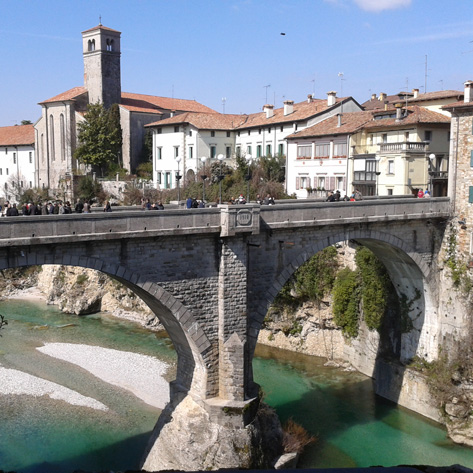The city of Cividale
 Surrounded
by charming Colli Orientali, the foothills of the Julian Alps with an
outlet in the plain, the city of Cividale del Friuli is located on the
banks of Natisone east of the city of Udine.
Surrounded
by charming Colli Orientali, the foothills of the Julian Alps with an
outlet in the plain, the city of Cividale del Friuli is located on the
banks of Natisone east of the city of Udine.
The
heir of the Roman Forum Julii preserves the appearance of old town,
divided into quaint villages, which become the perfect setting for the
unfolding of some important cultural events, such as the Mass of the
Broadsword, Mittelfest and San Donato's Palio.
The
important medieval monuments on its territory testify to its past
cultural, historical and military, due to the position of guarding the
passage between the Natisone's valley and the Istria's valley.
The
altar of Ratchis and around the temple, combined with relics preserved
in the National Archaeological Museum, become essential steps for
the understanding of the Lombard period.
Then the Roman ruins, the Cathedral Gothic and Renaissance palaces,
combined with the superb natural landscapes created by Natisone's river,
complete a picture of the most important art of Friuli Venezia Giulia,
so that it became a World Heritage Site by UNESCO in 2012.
Cividale
not only shows many artistic, cultural and urban elements, but also
offers a wide variety of flavors and gourmet products of its two
thousand year old tradition, which you can discover and enjoy the many
restaurants, holiday cottages and delicatessen shops located in the
center and out of town.

Surrounded
by charming Colli Orientali, the foothills of the Julian Alps with an
outlet in the plain, the city of Cividale del Friuli is located on the
banks of Natisone east of the city of Udine.
The heir of the Roman Forum Julii preserves the appearance of old town, divided into quaint villages, which become the perfect setting for the unfolding of some important cultural events, such as the Mass of the Broadsword, Mittelfest and San Donato's Palio.
The important medieval monuments on its territory testify to its past cultural, historical and military, due to the position of guarding the passage between the Natisone's valley and the Istria's valley.
The altar of Ratchis and around the temple, combined with relics preserved in the National Archaeological Museum, become essential steps for the understanding of the Lombard period.
Then the Roman ruins, the Cathedral Gothic and Renaissance palaces, combined with the superb natural landscapes created by Natisone's river, complete a picture of the most important art of Friuli Venezia Giulia, so that it became a World Heritage Site by UNESCO in 2012.
Cividale not only shows many artistic, cultural and urban elements, but also offers a wide variety of flavors and gourmet products of its two thousand year old tradition, which you can discover and enjoy the many restaurants, holiday cottages and delicatessen shops located in the center and out of town.
The heir of the Roman Forum Julii preserves the appearance of old town, divided into quaint villages, which become the perfect setting for the unfolding of some important cultural events, such as the Mass of the Broadsword, Mittelfest and San Donato's Palio.
The important medieval monuments on its territory testify to its past cultural, historical and military, due to the position of guarding the passage between the Natisone's valley and the Istria's valley.
The altar of Ratchis and around the temple, combined with relics preserved in the National Archaeological Museum, become essential steps for the understanding of the Lombard period.
Then the Roman ruins, the Cathedral Gothic and Renaissance palaces, combined with the superb natural landscapes created by Natisone's river, complete a picture of the most important art of Friuli Venezia Giulia, so that it became a World Heritage Site by UNESCO in 2012.
Cividale not only shows many artistic, cultural and urban elements, but also offers a wide variety of flavors and gourmet products of its two thousand year old tradition, which you can discover and enjoy the many restaurants, holiday cottages and delicatessen shops located in the center and out of town.







